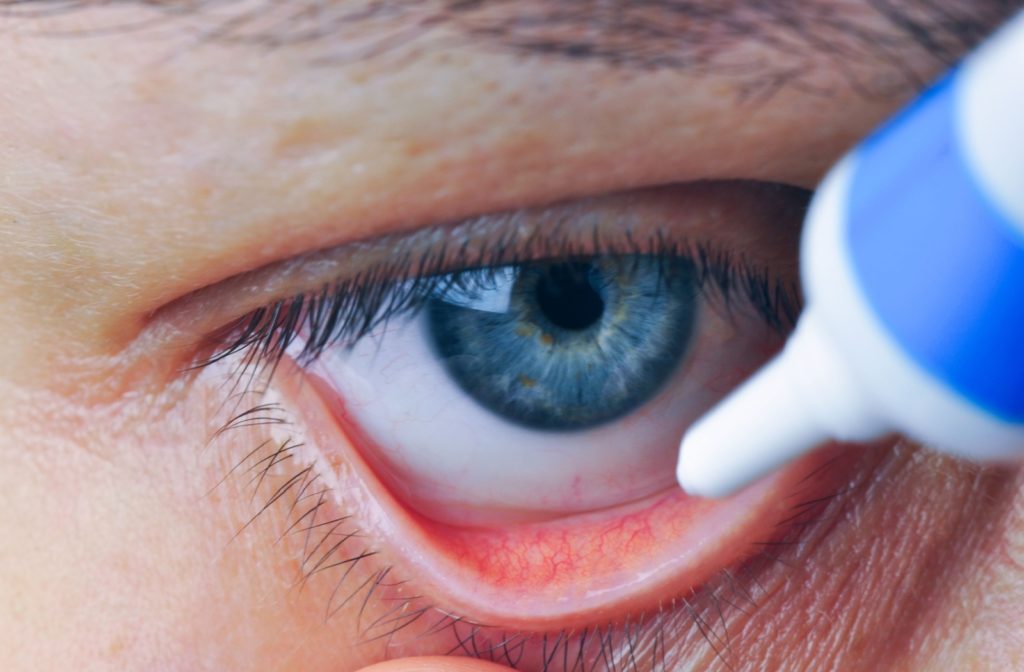Applying eye ointment may seem daunting at first, but it’s an important aspect of eye care that makes sure your eyes receive the care they need. Whether you’re dealing with an infection, inflammation, or dryness, knowing the correct way to apply eye ointment can make a significant difference in the effectiveness of the medication.
A step-by-step guide on how to properly apply eye ointment includes:
- Begin by washing your hands
- Prepare the ointment without contaminating the tip
- Sit comfortably and tilt your head back
- Pull down your lower eyelid to create a pocket
- Squeeze a small strip of ointment into the pocket
- Close your eyes for 1-2 minutes
- Wipe away excess ointment and wash your hands again
Discover exceptional eye care for the whole family at Total Vision Tierrasanta. Our dedicated team offers comprehensive eye exams for all ages, from children to seniors, ensuring lifelong vision health. Specializing in dry eye care, myopia control, and much more, we use advanced technology to provide excellent care.
The Importance of Proper Application
Eye ointments are often prescribed by doctors to treat a variety of eye conditions. Proper eye ointment application is essential to ensure the medication works effectively and to avoid any potential complications.
Incorrect application can lead to discomfort, reduced effectiveness, and even infections. By following the correct procedure, you can help your eyes heal faster and more efficiently.
Step-by-Step Guide on Applying Eye Ointment
The following are the steps to apply eye ointment correctly:
Step 1: Wash Your Hands
Before you begin, wash your hands thoroughly with soap and water. This step is crucial to prevent any germs or bacteria on your hands from entering your eye.
Step 2: Prepare the Ointment
Remove the cap from the eye ointment tube and place it on a clean surface. Be careful not to touch the tip of the tube to avoid contamination. If the ointment is in a single-use packet, open it carefully.
Step 3: Position Yourself Comfortably
Sit or lie down in a comfortable position. Make sure you’re in a well-lit area so you can see what you’re doing.
Step 4: Tilt Your Head Back
Tilt your head back slightly and look up at the ceiling. This position makes it easier to apply the ointment without blinking.
Step 5: Pull Down Your Lower Eyelid
With one hand, gently pull down your lower eyelid to create a small pocket between your eyelid and your eye.
Step 6: Apply the Ointment
Hold the tube of ointment with your other hand, and squeeze a small strip (about 1/4 inch) of ointment into the pocket you’ve created. Be careful not to let the tip of the tube touch your eye or eyelid.
Step 7: Close Your Eyes
After applying the ointment, close your eyes gently for 1-2 minutes. This allows the ointment to spread evenly over the surface of your eye.
Step 8: Wipe Away Excess Ointment
Use a clean tissue to wipe away any excess ointment from around your eye. Avoid rubbing your eyes.
Step 9: Wash Your Hands Again
Wash your hands once more to remove any ointment residue.

Tips for Safety & Effectiveness
- Follow Your Doctor’s Instructions: Always use the eye ointment as prescribed by your doctor. Do not use more or less than the recommended amount.
- Avoid Contamination: Do not touch the tip of the ointment tube to any surface, including your eye or hands. Keep the cap on when not in use.
- Store Properly: Store the ointment in a cool, dry place, away from direct sunlight. Make sure it’s out of reach of children.
- Be Patient: Ointment can cause temporary blurred vision. Avoid activities that require clear vision, such as driving, immediately after application.
- Check Expiry Dates: Do not use expired eye ointment. Always check the expiry date before use and dispose of expired products properly.
What is Eye Ointment Prescribed For?
Eye ointment is typically prescribed for a variety of eye conditions, including:
- Infections: Bacterial infections like conjunctivitis (pink eye) often require antibiotic ointments.
- Inflammation: Conditions such as blepharitis or uveitis may be treated with anti-inflammatory ointments.
- Dry Eyes: Lubricating ointments help relieve severe dryness and irritation.
- Injuries: To promote healing and prevent infection in cases of corneal abrasions or other eye injuries.
- Post-Surgery: To aid in recovery and prevent infection after eye surgeries.
It is important to always follow your healthcare provider’s instructions when using eye ointment.
For Further Assistance, Contact Us
Proper eye ointment application is a simple yet important part of eye care. By following these steps and tips, you can make sure that your eyes get the best possible treatment, reducing the risk of complications and speeding up the healing process.
Take charge of your family’s eye health by booking an appointment at Total Vision Tierrasanta! Our skilled professionals offer compassionate eye care services, including thorough exams, dry eye treatment, and myopia management. Scheduling is easy—visit our website or call us today to secure your spot and experience the exceptional care your eyes deserve.


